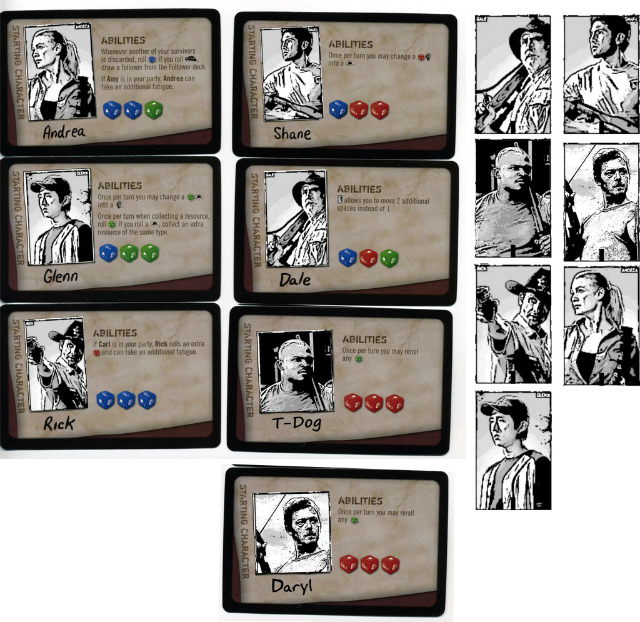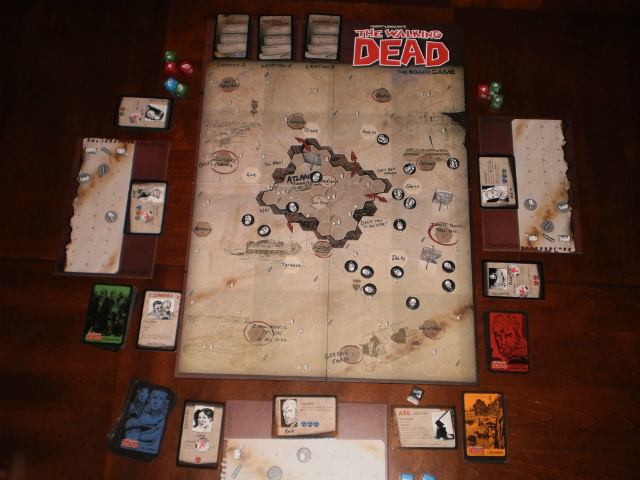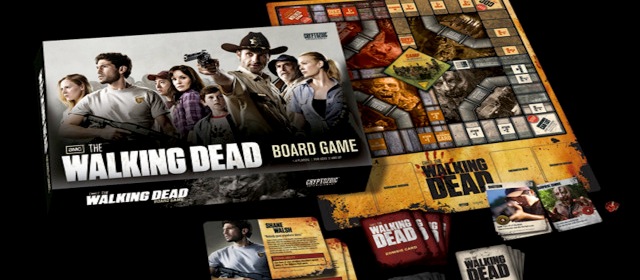If there’s one thing that’s popular right now, it’s zombies. Whether that’s in comics books, TV or films, you can’t get away from the flesh-eating undead. In recent years that fact has been thanks, in no small part, to Robert Kirkman’s ‘The Walking Dead’. Finding it’s feet in the world of comics books, it’s recently made its way to our TV sets thanks to AMCs hugely popular portrayal of Rick Grimes and his crew, there’s even been a couple of video games – the underwhelming “The Walking Dead: Survival Instincts” and the overwhelming “The Walking Dead” from Telltale Games.
One piece of the The Walking Dead pie that’s been overlooked by a lot of people is the couple of incarnations that have made their way to the world of board games. We recently had the chance to sit down with Z-Man Games’ The Walking Dead board game, which tasks the player with simply finding resources and scouting locations as possible safe havens. The game is all about survival, just as the source material is, but does that make it an interesting game to play? Is it fun? Does it stay true to the universe that it’s a part of?

Upon sitting down to play The Walking Dead: The Board Game, the first thing that people are going to do is pop out all of the pieces. The game is played with a vast amount of tokens that represent the many areas of the game, from zombies to followers through to fatigue markers. These all come on sheets of cardboard that, before play is commenced for the first time, need to be sorted out and arranged into their various piles. There’s no doubt that the game is one that needs quite a large amount of space to be set out in advance, even more so if you’re playing with the maximum number of players, which is six. Once you’ve got all of the tokens separated from the cardboard sheets they’re attached to, along with the character markers, you’re ready to start the game.
Players place their assigned character, which is chosen at random, on the designated starting point for that person. A follower is then selected, also at random, from the “Follower” deck of cards. If there is anything assigned to this card, such as the ability to pick up resources just for having that follower, the player must do so before the action starts. Once the game starts each player is allowed to take it in turns to move one, two or three spaces in any direction, with the aim of the game being to collect the resources you need and get to three locations. The first person to get to three different locations wins the game. Locations aren’t just chosen at random though, when the game starts, three locations are turned over and placed at the top of the board – these are the publicly-known safe havens – then each player turns over a privately-known safe haven and keeps the information to themselves; if you’re lucky, the private safe haven is somewhere close to where your character starts the game. If you’re not so lucky then it could be at the other side of the board and, if you want to scout it, you’re going to have to do some walking.

When landing on a resource location, the player must turn over one of the “Encounter” cards for every resource in that location. For example, if the location has a fuel resource and a food resource, the player must turn over two “Encounter” cards and perform the actions that’s listed on them. These actions could be anything from having a certain number of resources or followers through to having to defeat a certain number of walkers. Each of the cards has a “Success” and “Failure” scenarios which the player must also play through depending one whether they pass the encounter’s scenario or not.
The catch with The Walking Dead: The Board Game is that each time you move from a location, because of the disturbances that you made while you were there, you attract a couple of walkers. The player must always place a zombie token at the location they were previously standing whenever they move. This makes it more difficult to retrace your steps and keeping players moving forward instead of sticking to the same location for the entirety of the game. When playing with just two players as we were, however, the feature doesn’t really add much to the game as the board doesn’t fill up with walkers nearly as quickly as would be needed to make the experience more exciting. As it stands, with just a couple of players, it’s much too easy to just go around the walkers and not force yourself into encounters; this makes the game on the whole a little less exciting that it would otherwise have been.

VERDICT: The Walking Dead: The Board Game has a nice enough concept, and with enough people together the game mechanics could work to make the entire experience a little bit more enjoyable, but with just a couple of people, players will find the game world much too big to pose any kind of serious threat. The end-game scenarios could do with a little bit more work too – there’s too high a chance that players will just end up repeating the same things over and over again, moving out and back into the last locations they need to win, only to fail at the encounters that they’re presented with, forcing them to do the same thing over and over again. No matter how good the start and middle of a game are, and they’re both really entertaining here, if the end-game isn’t much to write home about then the whole experience is going to quickly be soured. The Walking Dead: The Board Game isn’t a bad experience, but it’s one that needs a little bit of work to be truly enjoyable. Still, it’s worth a shot if you’re a fan of the source material.





